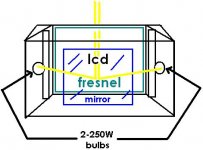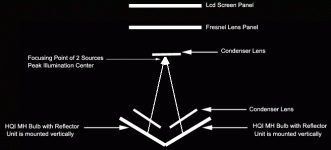sorry guys about the crude drawing but heres something i was thinking about. I figured 2 250W bulbs would be better than one, and if we could find a way to use them that we would get better results - basically its two bulbs aimed at a mirror at a certain angle, i am guessing 45 degrees, to combine both beams into a stronger one.
what do you guys think? not good?
hit me with it
what do you guys think? not good?
hit me with it

Attachments
I was trying to understand how you can get the 2 original beams to change directions at right angles so closely to each other.
The mirror for the left bulb would have to be at 45 degree angle
and so would the one from the right but at the opposite angle. One mirror would block the beam from the other would it not?
The mirror for the left bulb would have to be at 45 degree angle
and so would the one from the right but at the opposite angle. One mirror would block the beam from the other would it not?
The only way I can think of that you might get this to work is if you mount the lights on either side of the front of the assembly pointed backwards and then use a concave mirror. Even then I have my doubts about focusing.
ok the angles in teh drawing are obviously off, but heres the thing, mount the lights at a 45 degree angle, the should coiincide at a point in the center of the mirror if th emirror is far enough and they should combine into one beam, this is theoretically of course, please undertsand the drawing is off by porportions and degrees
ok maybe its easier if i mention teh fact that the mirror is laying flat, it is not mounted in any particular angle, the light bulbs are mounted at a 45 degree angle, thats all 🙂
Angle of..shoot..I forgot the sentence, but the angle that the light comes on to the mirror is the same angle it will come off of it. You can easily see this with a laser pointer. This means the light wont go straight up, it will go back at the other lightbulb.
shoot, excellent feedback sir_vival, excellent, id overlooked that, theres a way to get around it though, theres always a way 😉
If you set your bulbs at 45 degree angles, then you need to mount two mirrors at 67.5 degree angles ( or 22.5 degrees off of the the perpendicular ( spelling? ) axis of the LCD. In any case, I think that everyone else in this post has a point with the light spillage that you will have from trying to angle your lenses/ mirrors perfectly.
If you get to go, make sure that you post the pics!
If you get to go, make sure that you post the pics!
angle of incidents is equal to angle of reflectance.
The mirror is going to end up blocking one of the beams.
Try it out with just 2 flashlights or something you will see what I mean.
The mirror is going to end up blocking one of the beams.
Try it out with just 2 flashlights or something you will see what I mean.
But now that you got me thinking about it I think I found a way to get around it. It will be easier to draw it and show it that way. I will post later today or tomorrow with the drawing.
Isnt is going to give a double image? I mean unless you manage to join the beams before the LCD stage, isnt it just going to project 2 images offset by the diffrence of the point sources?
This is prettymuch has the same objective that I was asking about in my Omni-Hax thread. Except I was thinking of orthagonal light paths through a prism donated by a used/broken tri-LCD projector.
CB.
This is prettymuch has the same objective that I was asking about in my Omni-Hax thread. Except I was thinking of orthagonal light paths through a prism donated by a used/broken tri-LCD projector.
CB.
i think with that scheme the condenser lens may have to be at quite a distance, or maybe be of a very good size so that no light excapes

As said b4 in other threads, you can not "mix" light from multiple sources without serious hardware (eg a huge version of the prisms as used in 3lcd projectors).
Its is not important to get the light converged to 1 point; you have to get all the rays pointing in the same, or at least a known/usable, direction.
No design with mirrors and lenses can do that.
When in doubt:
Draw a single bulb, condensor lens (optional) and the fresnel lens. Add a few light beams at different angles from the bulb through the optional condensor to the fresnel.
Do the same for your multi light setup (only include parts upto the fresnel)
Now compare the drawings; if the rays do not hit the fresnel at the same angle on both drawings it wont work. And remember we live in a 3D world!
Or try the search function🙄
Its is not important to get the light converged to 1 point; you have to get all the rays pointing in the same, or at least a known/usable, direction.
No design with mirrors and lenses can do that.
When in doubt:
Draw a single bulb, condensor lens (optional) and the fresnel lens. Add a few light beams at different angles from the bulb through the optional condensor to the fresnel.
Do the same for your multi light setup (only include parts upto the fresnel)
Now compare the drawings; if the rays do not hit the fresnel at the same angle on both drawings it wont work. And remember we live in a 3D world!
Or try the search function🙄
- Status
- Not open for further replies.
- Home
- General Interest
- Everything Else
- The Moving Image
- DIY Projectors
- Theory on how to double light intensity

